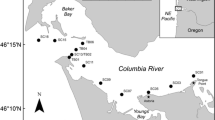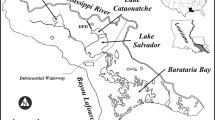Abstract
A study of the phytoplankton community dynamics in Navigation Pool No. 7 of the Upper Mississippi River was conducted from May through October, 1982. The objectives of this study were to estimate total standing crops, determine the taxonomic composition and examine the seasonal succession of the phytoplankton community. Four sampling sites were established: two in Lake Onalaska, a large backwater lake on the Wisconsin side of the main channel; one in the main channel near Dakota, Minnesota; and one in the main channel just upstream from Lock and Dam No. 7.
The phytoplankton communities at all sampling sites were dominated by diatoms except during July and August when a bloom of blue-green algae was observed. The dominant diatoms from May through mid-July were Melosira italica, Stephanodiscus niagarae, Stephanodiscus hantzschii, Stephanodiscus astrea, and Synedra ulna. Aphanizomenon flos-aquae and Microcystis aeruginosa were the most prevalent blue-green algae during the mid-summer bloom. The diatoms Melosira italica and Melosira granulata were dominant in September and October. Lesser amounts of green algae, cryptomonads and euglenoids were also observed at various times of the sampling period.
Total standing crops based on cell volume were usually greatest at the Lock and Dam No. 7 site. The maximum standing crop (10.4 mm3 1−1) was observed at the Lock and Dam No. 7 site on 4 September; the minimum standing crop (0.4 mm3 1−1) was observed at the eastern Lake Onalaska site on the same date. Concentrations of nitrogen, phosphorus, and silica remained at high levels throughout the study period and did not appear to limit phytoplankton standing crops.
Similar content being viewed by others
References
American Public Health Association, 1981. Standard methods for the examination of water and wastewater. 15th Ed., APHA, New York, N.Y.
Baker, A. & K. Baker, 1979. Effects of temperature and current discharge on the concentration and photosynthetic activity of the phytoplankton in the Upper Mississippi River. Freshw. Biol. 9: 191–198.
Cary, G., 1972. A quantitative survey of the phytoplankton and water quality of La Crosse, ‘Black’, and Mississippi Rivers. M.S. Thesis. University of Wisconsin-La Crosse, La Crosse, WI. 41 pp.
Chandler, D. C., 1942. Limnological studies of western Lake Erie. III. Phytoplankton and physical-chemical data from November, 1939 to November 1940. Ohio J. Sci. 42: 24–44.
Findinegg, I., 1969. Expressions of populations. pp. 16–18. In R. A. Vollenweider, (ed) Primary production in aquatic environments. Burgess and Son, Great Britain.
Fogg, G. E., 1969. The physiology of an algal nuisance. Proc. r. Soc. 173.
Hustedt, Von F., 1959. Die Kieselalgen 2. Teil. Akademische Verlagsgesellschaft m.b.H. Leipzig, Germany.
Hustedt, Von F., 1961. Die Kieselalgen 3. Teil. Akademische Verlagsgesellschaft m.b.H. Leipzig, Germany.
Hustedt, Von F., 1962. Die Kieselalgen 1. Teil. Akademische Verlagsgesellschaft m.b.H. Leipzig, Germany.
Hutchinson, G. E., 1967. A treatise on Limnology. Vol. II. Introduction to lake biology and limnoplankton. John Wiley & Sons, Inc., New York, N.Y. 1115 pp.
Hutchinson, G. E., 1973. Eutrophication. Am. Sci. 61: 269–279.
Jackson, G. A., C. E. Korschgen, P. A. Thiel, J. M. Besser, D. W. Steffeck & M. H. Bockenhauer, 1981. A long term resource monitoring plan for the Upper Mississippi River System. Report to Upper Mississippi River Basin Commission. Bloomington, Mn. 2 vol.
Lund, J. W. G., 1954. The seasonal cycle of the plankton diatom, Melosira italica (Ehr.) Kutz. subsps. subartica O. Mull. J. Ecol. 42: 151–179.
Lund, J. W. G., 1971. An artifical alteration of the seasonal cycle of the plankton diatom Melosira italica subsp. subartica in an English lake. J. Ecol. 59: 521–533.
Luttenton, M., 1982. An investigation of factors affecting the distribution and abundance of phycoperiphyton in Navigation Pool No. 5, Upper Mississippi River. M.S. Thesis, University of Wisconsin-La Crosse, La Crosse, WI. 118 pp.
Murphy, T. P., K. J. Hall & I. Yesaki, 1983. Coprecipitation of phosphate with calcite in a naturally eutrophic lake. Limnol. Oceanogr. 28: 58–69.
Ozburn, C. C. 1969. A diatom population and nutrient survey in the Mississippi River at Lock 7 and Lock 8. M.S. Thesis. University of Wisconsin-La Crosse, La Crosse, WI. 120 pp.
Patrick, R., 1969. Some effects of temperature on freshwater algae, pp. 161–185. In Krenkel, P. A. & F. L. Parker, (eds) Biological Aspects of Thermal Pollution. Vanderbilt University Press.
Patrick, R. & C. W. Reimer, 1966. The diatoms of the United States, Vol. 1. Acad. of Nat. Sci. Phila. Philadelphia, PA. 688 pp.
Patrick, R. & C. W. Reimer, 1975. The diatoms of the United States, Vol. 2. Acad. of Nat. Sci. Phila. Philadelphia, PA. 213 pp.
Prescott, G. W., 1951. Algae of the Western Great Lakes Area. Cranbrook Inst. of Sci., Bloomfield Hills, MI.
Prescott, G. W., 1961. Algae of the Western Great Lakes Area, Wm. C. Brown Co., Dubuque, IA. 977 pp.
Prescott, G. W., 1970. How to Know the Freshwater Algae. Wm. C. Brown Co., Dubuque, IA.
Rada, R. G., 1974. An investigation into the trophic status of Canyon Ferry Reservoir, Montana. Ph.D. Dissertation, Montana State University, Bozeman, MT. 126 pp.
Sawyer, C. N., 1947. Fertilization of lakes by agricultural and urban drainage. J. New England Water Works Assoc. 61: 109–127.
Sawyer, C. N., 1952. Some new aspects of phosphates in relation to lake fertilization. Sewage and Industrial Wastes 24: 768–776.
Smith, G. M., 1950. The freshwater algae of the United States. 2nd ed. McGraw-Hill, New York, N.Y. 719 pp.
Strenski, M. R., 1979. The phycoperiphyton community of the Lower Black River, Wisconsin. Trans. Wis Acad. Sci., Arts, Letters 67: 69–77.
Taft, C. E. & C. W. Taft, 1971. The algae of Western Lake Erie. Bull. of the Ohio Benthological Survey. Ohio State University, Columbus, OH.
United States Environmental Protection Agency, 1979. Methods for chemical analysis of water and wastes. USEPA, Cincinnati, OH.
Van Steenberg, J. B., 1983. Effects of the Dairyland Power Company electrical generating facility on the phycoperiphyton in Navigation Pool No. 9, Upper Mississippi River. M.S. Thesis, University of Wisconsin-La Crosse, La Crosse, WI.
Vollenweider, R. A., 1968. Scientific fundamentals of the eutrophication of lakes and flowing waters with particular reference to nitrogen and phosphorus as factors in eutrophication. Paris.
Weber, C. I., 1971. A guide to the common diatoms at water pollution surveillance system stations. USEPA.
Wetzel, R. G., 1972. The role of carbon in hard-water marsh lakes. In Likens, G. E. (ed.), Nutrients and Eutrophication. Spec. Publ. Amer. Soc. Limnol. Oceanogr. 1: 84–97.
Whitford, L. A. & F. J. Schumacker, 1973. A manual of freshwater algae. Sparks Press, Raleigh, NC.
Author information
Authors and Affiliations
Rights and permissions
About this article
Cite this article
Huff, D.R. Phytoplankton communities in navigation pool no. 7 of the Upper Mississippi River. Hydrobiologia 136, 47–56 (1986). https://doi.org/10.1007/BF00051503
Issue Date:
DOI: https://doi.org/10.1007/BF00051503




